
|
|||
|
FORT WORTH |
|||
| HOME TEXAS REGIONS | |||
|
|||
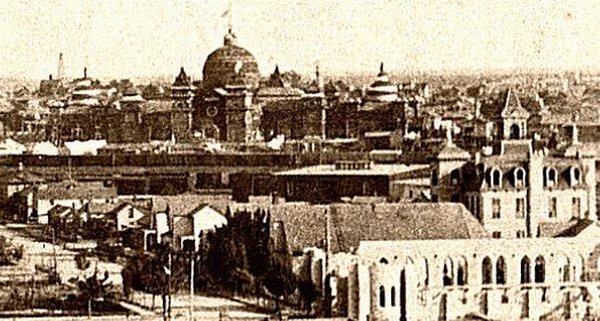
|
|||
| Click here for a map showing the location of the Spring Palace | |||
|
Lancaster Avenue, the location of the memorial to Alfred Hayne, has
undergone big improvements. The Hayne Memorial is now in a park-like setting. We've blogged about the improvements, with new photos. |
|||
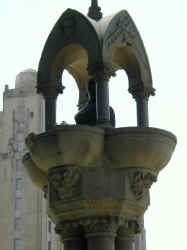
|
click a thumbnail to view a photo TEXAS SPRING PALACE. The Texas Spring Palace, a regional immigration and agricultural fair located in Fort Worth, opened on May 29, 1889. The fair was inspired by an idea of Robert A. Cameron, immigration agent for the Fort Worth and Denver Railway, and designed to attract settlers and investors to Texas. Cameron devised a plan to advertise Texas by displaying all the natural products of the state under one roof in a building intended to rival the Sioux City Corn Palace and Toronto Ice Palace in novelty and style. Fort Worth's civic leaders and newspapers quickly adopted the plan, and local railroads became co-sponsors of the project. Subscriptions from local businesses and citizens furnished construction funds. Meanwhile, a bandwagon effect spread support for the fair throughout the state. The completed Spring Palace, built in record time (thirty-one days) by the Fort Worth Loan and Construction Company, served as an educational, cultural, and entertainment center for Texas residents and guests throughout the month of June. With its exterior walls painted a dark bronze green; its roof sporting both turnip-shaped cupolas and a massive center dome surpassed in size only by that of the national Capitol in Washington; and wheat, cotton, and other products of Texas covering the entire structure, the Spring Palace building looked like something out of a fantasy world. Inside the oriental-style exhibit hall, settlers and investors could find neatly classified samples of most grains, grasses, fruits, vegetables, and minerals produced within the state.
|
||
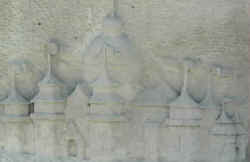 |
Visitors interested in aesthetic pursuits could also tour floral, historic, scientific, and art exhibits or view mosaics depicting Texas scenes-all made from natural products by the women of the state. Over fifty Texas counties contributed to these exhibits. Meanwhile, concerts by the Elgin Watch Factory Band and the Mexican National Band, vocal performances, political and religious orators, dances, and sporting events competed with the exhibits for the visitors' attention. A second season, scheduled for May 10-31, 1890, proved especially popular but ended catastrophically. In spite of efforts to make the palace fireproof, a flash fire swept through the building on the night of May 30, leveling the structure in a matter of minutes. Although several thousand people were attending a dance in the palace that night, only one life, that of Englishman Al Hayne, was lost. Hayne died as a result of his efforts to save women and children who had not yet escaped from the burning building. A fifteen-year-old girl named Ada Large also heroically aided those trapped by the flames and was later given a medal by the city. Because its destruction occurred after only a two-year existence, the Spring Palace hardly had time to establish itself as a power in the state's immigration crusade. Yet contemporaries claimed measurable benefits for both Texas and Fort Worth as a result of the project. Texans and their guests learned a great deal about the cultural and physical resources and potential of their state, and newspapers from across North and West Texas credited the palace's educational campaign for attracting settlers and investments in 1889 and 1890. |
||
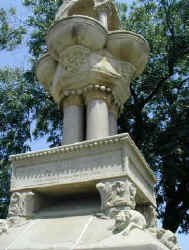
|
Meanwhile, important newspapers in St. Louis, Boston, and New York published columns on the Spring Palace, thus focusing national attention on Texas and Fort Worth. As a result of this publicity, 28 percent of the visitors to the fair came from outside the state; and travelers from England, Belgium, Scotland, Iceland, Canada, and Mexico took the Texas booster message abroad after touring the Spring Palace exhibits. Fort Worth benefited especially. The Spring Palace brought additional businesses and factories to the town, and new buildings appeared as eastern financiers invested in the city's future. Population and real estate and tax values rose accordingly. Local trade increased as well. Despite these proofs of the contributions of the immigration fair, Fort Worth and Texas citizens failed to rebuild the Spring Palace. The city of Fort Worth tried to revive the exhibit for the next ten years. A new Spring Palace committee was set up in 1900 to draw up plans, and the board of trade voted $10,000 to help. Plans eventually called for a Spring Palace auditorium, speedway, amphitheater, and theater garden. The principal motivation was to compete with the annual State Fair that rival city Dallas had acquired. Eventually, the annual Fort Worth Fat Stock Show grew out of this sentiment, and its success, plus the inability of civic leaders to raise enough money to get the Spring Palace started again, killed the whole idea. The city's central post office and adjacent railroad yards now occupy the Spring Palace site. A monument to Al Hayne stands in a small median between the traffic lanes of Main Street east of the palace's old Lancaster Street location. |
||
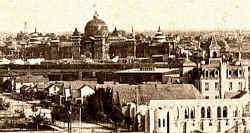
|
|
||
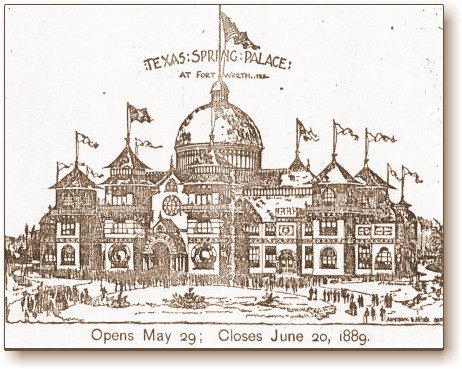
|
|||
|
|
|||
|
|||

|
|||

|
|||
|
Visit our Eyes on Texas Blog
to make a comment about the Spring Palace |
|||
|
|
|||
| HOME TEXAS TOWNS PARADES | |||
|
|
|||
| BIG BEND COUNTRY | |||
| GULF COAST PINEY WOODS | |||
| PRAIRIE & LAKES HILL COUNTRY | |||
| SOUTH TEXAS PLAINS | |||
| PANHANDLE PLAINS | |||
|
|
|||
| Fort Worth Spring Palace | |||
| Fort Worth's Lost Heritage | |||
| Tandy Hills Park | |||


